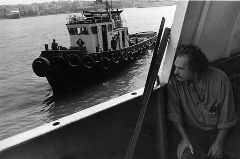

|
Jannis Kounellis was born in 1936 in Piraeus, the port where the vessel IONION now temporarily lies moored with her rather unusual cargo of works produced by the artist over the last thirty years. Kounellis left Greece for Italy in 1956: he found the artistic stimulus that he sought in Rome, where he eventually settled. Early on, his studies at the Academy of Fine Arts, and his contact with the greatest masterpieces of Italian painting of the period 1200-1600 (specifically, the works of Giotto, Masaccio and Caravaggio, in Rome, Florence, Venice and elsewhere), helped him to develop his own notions of space and form.
Since his first show in Rome in 1960, Kounellis has voyaged far and wide. His regular ports of call range from Rome to Berlin, from Naples to Paris, from Genoa to Rotterdam, from Cologne to New York, from Munich to London, from Chicago to Nagoya, from Montreal to Barcelona, from Los Angeles to Prague, from Moscow to Athens. In his travels across the world and through a variety of cultural milieux -and in his quest for profounder understanding- Kounellis has mastered a visual language which is all his own; and which, within the context of the art of his generation, he has elaborated and refined into a creative continuum based on an intensely personal spatial sensibility.
The chapters of his book, A Lagoon Odyssey, which chronicle his intellectual and artistic wanderings and quests, are named after certain of his works: Carboniera (1967), Horses (1969), Fires (1969), Apollo (1973), The Citizens' Tragedy (1975), Albatros (1991), and others, down to this project on board the MV IONION berthed in one of the largest ports in Europe. As on the Giudecca Canal in Venice in 1974, so now in Piraeus, this floating exhibition reflects for Kounellis not so much a type of location as his own continual and natural adoption of kindred places: places ready to receive the shapes and forms of his intense visual imagination and creative freedom. In this sense, the MV IONION symbolises a place of endless mobility, analogous to the movements in history and art to which Kounellis's life is closely bound.